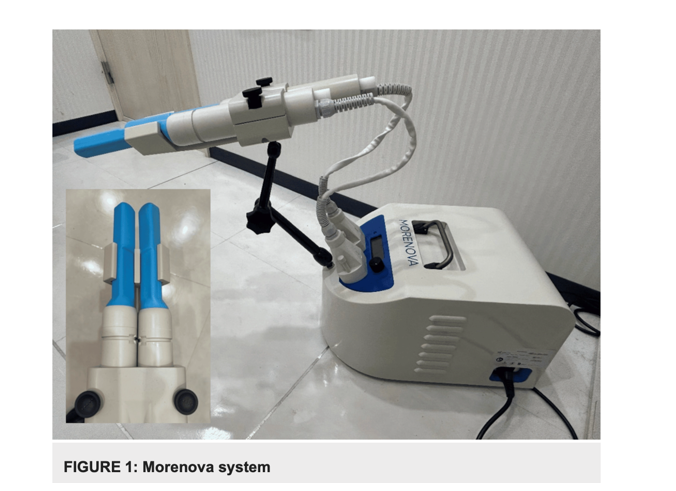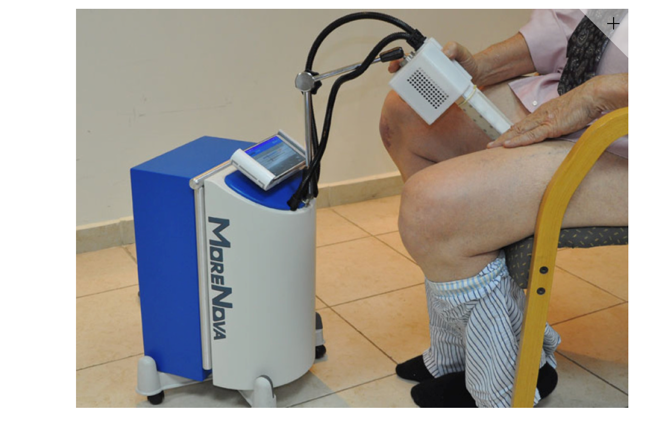Kato J. et al., 2025: Efficacy, Satisfaction, and Safety of Low-Intensity, Large-Area Shock Wave Therapy With Dual-Probe Energy Delivery for Erectile Dysfunction.
Jun Kato 1, Masato Shirai 2, Keisuke Ishikawa 2, Akira Tsujimura 2
1Department of Urology, East Ekimae Clinic Shinbashi, Tokyo, JPN.
2Department of Urology, Juntendo University Urayasu Hospital, Urayasu, JPN.
Abstract
Objective: We evaluated the efficacy and safety of a new low-intensity extracorporeal shockwave therapy generator, the Morenova system (Direx Systems GmbH, Wiesbaden, Germany), that offers fewer treatments and shorter treatment times through dual-probe energy delivery for patients with erectile dysfunction (ED). We additionally examined whether aging affects treatment efficacy and whether there are independent factors that predict treatment efficacy. To evaluate efficacy from the viewpoint of patient satisfaction, free comments written by the patients were analyzed by artificial intelligence (AI) to clarify the percentage of responses judged to be "positive."
Methods: This study included 64 male patients (56.5 ± 1.5 years) with ED who had undergone treatment with the Morenova. The treatment involves delivering a total of 1,800 shock waves (900 from each of the two applicators) with an energy density of 1.8 mJ/mm2 to the sides of the penis and the perineum. Each patient underwent five sessions conducted two to three times per week. Efficacy was evaluated by two specific questionnaires (Sexual Health Inventory for Men, SHIM, and Erection Hardness Score), and adverse events were confirmed by direct questioning of the patients. The degree of improvement was evaluated for five age groups of patients categorized in their 30s, 40s, 50s, 60s, and 70s and older. The patients' free-form feedback on their impressions and opinions of the treatment was also evaluated by AI.
Results: We found significant improvement between pretreatment and one-month posttreatment score of the SHIM (from 11.5 ± 0.5 to 16.6 ± 0.7; p < 0.01) and Erection Hardness Score (from 1.94 ± 0.09 to 2.83 ± 0.10; p < 0.01), respectively. Significant improvement between pretreatment and three-month posttreatment scores from the two questionnaires was also found (from 11.5 ± 0.5 to 16.6 ± 0.7; p < 0.01 and from 1.94 ± 0.09 to 2.66 ± 0.13; p < 0.01, respectively). Morenova treatment caused no adverse events. The degree of improvement was not affected by the patients' age. Only pretreatment Erection Hardness Score was found to be an independent influencing factor for the efficacy of the treatment. Analysis by AI of patients' free-form feedback showed that 70% of the opinions were positive.
Conclusions: We concluded that treatment with the Morenova system is an effective and safe option for ED, which should be tried in all age groups, as approximately 70% of patients reported satisfaction with the treatment. The patients appeared to be satisfied with treatment by Morenova because of fewer clinic visits and shorter treatment times, coupled with a good response.
Cureus. 2025 May 3;17(5):e83389. doi: 10.7759/cureus.83389. PMID: 40462792; PMCID: PMC12131126.


Comments 1
Background


Erectile dysfunction (ED) has been increasingly recognized as a significant health issue, with a reported global prevalence of over 152 million in 1995, projected to rise to approximately 322 million by 2025. In Japan, a recent survey indicated a 30.9% prevalence of ED among men aged 20 and older, with around 14 million affected. Traditional first-line treatments include phosphodiesterase type 5 inhibitors (PDE5Is), but many patients remain dissatisfied due to ineffectiveness or adverse side effects. Consequently, alternative treatments like low-intensity extracorporeal shock wave therapy (Li-ESWT) have gained popularity, despite not being covered by national health insurance in Japan.
Study Objective
The study aimed to evaluate the efficacy, safety, and patient satisfaction associated with the use of the Morenova device for Li-ESWT in treating ED, particularly focusing on its dual-probe energy delivery system that enhances treatment coverage.
Morenova (Direx Systems) utilizes an electromagnetic linear generator with dual-probe energy delivery, achieving an energy density of 0.09 mJ/mm2, similar to the Renova (Figure).
Morenova is a compact lithotripter with a width of 290 mm, depth of 400 mm, height of 230 mm, and weight of 9 kg. Patients can be treated in a sitting position with legs slightly open.
Methods
- Participants: 64 male patients undergoing Morenova LiESWT treatment from May 2022 to March 2024, excluding those with specific medical conditions.
- Assessment tools: Included the Sexual Health Inventory for Men (SHIM) and Erectile Hardness Score (EHS) before and at one and three months post-treatment. Patients provided free-form feedback on their treatment experience.
- Treatment Protocol: Patients received five sessions of Li-ESWT, delivering a total of 1,800 shock waves (900 from each of the two applicators) to the sides of the penis and the perineum, each lasting approximately 20 minutes, with energy density set at 0.09 mJ/mm².There are no data about the frequency, but it should be about 2 Hz.
Results
- Patients showed statistically significant improvements in both SHIM and EHS scores after one month (SHIM: from 11.5 to 16.6; EHS: from 1.94 to 2.83) and maintained improvements at three months (SHIM: to 15.0; EHS: to 2.66).
- Satisfaction rates based on free-form comments indicated that around 70% of patients had a positive experience with the treatment, similarly aligned with previous studies.
- The efficacy of the treatment appeared consistent across different age groups, with greater improvements noted in patients exhibiting more severe ED symptoms prior to treatment.
Discussion
This study supports the potential of Morenova as a safe and effective treatment option for ED, especially for patients dissatisfied with PDE5Is. The reduced number of clinic visits and shorter treatment duration were well-received by patients. While promising, the researchers caution that Li-ESWT is still considered investigational, requiring further longitudinal studies and comparative analyses to establish its role against existing ED treatments
The study faced limitations such as a short observation period, a reduced number of patients assessed at three months, a lack of control group for placebo comparison, and the inability to analyze the impact of previous PDE5I use due to a small participant pool.
Conclusion
In conclusion, Morenova Li-ESWT appears to be a viable treatment alternative for ED with a satisfactory response rate among patients. The researchers recommend further research to clarify its effectiveness and positioning in the spectrum of ED therapies, as well as exploring the possibility of at-home treatment options in the future.
Jens Rassweiler